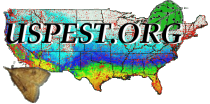

Muskmelon are affected by alternaria leaf blight, anthracnose, and gummy stem blight, all of which have similar disease cycles. Repeated treatment is economically necessary for production in some climates. The "MelCast" tool is intended to guide growers in scheduling treatments, based on how conducive weather conditions are to disease growth.
This app is a newer, streamlined interface for the existing model, which is also available through MyPest Page.
Select the "Inputs" tab, search for weather stations near you, and choose one either from a list or a map. Be aware that some weather stations have poor quality or missing data. Our software estimates the quality of each station, but you may wish compare results for several nearby stations.
Optionally, you may choose a start date and a span (number) of days. If you leave the start date blank, the end of the output will be five days in the future, using forecast weather data, and the app will count back to a start date in the recent past. The weather forecast data is from the National Weather Service's "NDFD" forecasts.
You may also select a reference date. The MelCast index is a cumulative sum of daily values, starting on the reference date. Depending on how you set up your record-keeping, you may wish to enter a date here. Common choices are the dates of transplanting, the first fungicide treatment, or the most recent treatment. If you do not enter a date, the start date will be used.
Then, select "Graph" or "Table" to run the model. Your output will appear after 10-20 seconds depending on server load.
The MelCast model characterizes how favorable each day's weather is to disease growth with an "environmental favorability index" or EFI. Each day's EFI is taken from a table, using hours of leaf wetness and the average temperature while the leaves are wet. Daily EFI values are added over consecutive days. These cumulative values are shown in this app's graph. Both Daily EFI and cumulative values are reported in the table.
This is not a complete guide to use of MelCast. One guide is available at Purdue's Melon Disease Forecaster page. A printable record sheet is also available. The guide describes the manual calculation of daily EFI values from weather data and keeping a running total of these values throughout the season, tasks which this app automates. It also describes using MelCast to time fungicide application. The main points are:
Disclaimer: The index is intended to inform your decisions about management actions, such as choice and timing of control measures and intensity of scouting. It should supplement, not replace, the other factors you consider in making these decisions. Use at your own risk.
Automated email delivery of the disease risk index outputs displayed in this app is available at no cost. An email subscription offers model results for this and several other plant disease models, for up to three weather stations, on a schedule that you select. To subscribe, you will need a uspest.org account.
Next, use one of these buttons to run the model and see the output in the form of your choice.
To get this information by email, log in to or sign up for USPEST.org email notifications. To see the model output together with relevant weather inputs, go to MyPest Page.
To get this information by email, log in to or sign up for USPEST.org email notifications. To see the model output together with relevant weather inputs, go to MyPest Page.